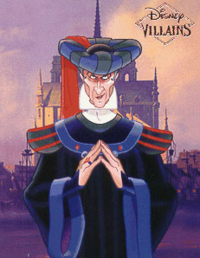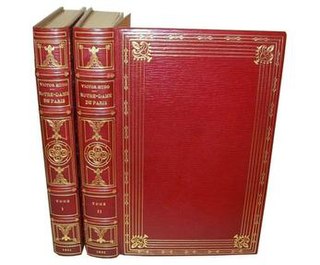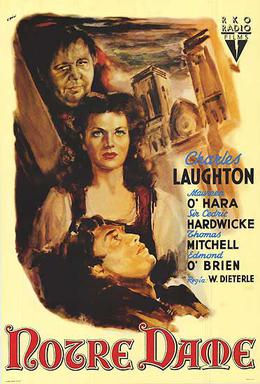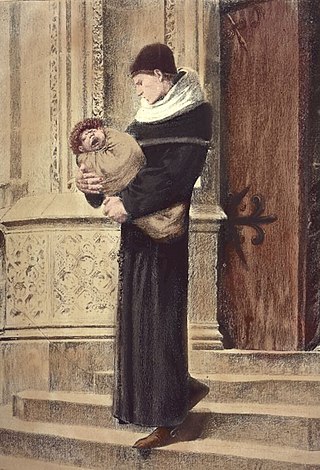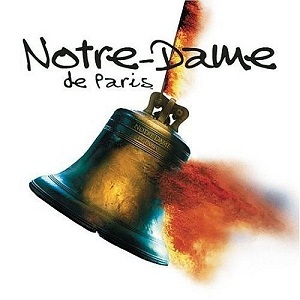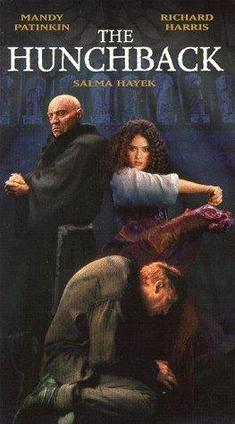The Hunchback of Notre Dame
In the film, Frollo and his soldiers capture a group of Romani people attempting to immigrate to Paris on a boat. A Roma woman in the group attempts to flee with her deformed baby, but Frollo kills her outside Notre Dame Cathedral, where the former sought sanctuary to escape from the latter. Fearing the baby's deformity, Frollo tries to kill it by throwing it into a nearby well to drown, but the cathedral's Archdeacon intervenes and accuses Frollo of murdering an innocent woman in front of the cathedral. Fearing divine retribution, Frollo reluctantly agrees to raise the deformed child in Notre Dame as his son, to atone for his sin and in the hope that the hunchback will someday be "useful" to him. He cruelly names the child "Quasimodo" (meaning "half-formed"), and teaches him that the world outside the cathedral is a sinful place full of people who would hate and shun him for his deformity, even lying that his mother had cruelly tried to drown him and that Frollo saved him from this fate.
Twenty years later, in the Palace of Justice, Frollo appoints a new Captain of the Guard, Phoebus, stating his intent to eradicate the city's Romani population by discovering their sanctuary, the "Court of Miracles". While attending the annual Festival of Fools, Frollo discovers a Romani dancer, Esmeralda, who dances in front of him and kisses him on the nose. He finds that Quasimodo has left the bell tower and joined the Festival. Even after being crowned King of the Fools for his deformity, Quasimodo is humiliated by the crowd after two of Frollo's guards start a riot. To teach him a lesson for disobeying him, Frollo postpones helping Quasimodo, going so far as to refuse Phoebus' request to stop the cruelty, until Esmeralda defiantly frees Quasimodo. Esmeralda berates Frollo for refusing to help Quasimodo, as well as his cruel treatment of travellers and other outcasts, and uses a magic trick to evade arrest. Phoebus refuses to arrest her for witchcraft inside Notre Dame and instead tells Frollo that she has claimed sanctuary inside the cathedral; the Archdeacon orders Frollo and his men out, reminding him of his promise of never again assaulting the cathedral.
In the fireplace chamber of the Palace of Justice, Frollo lusts after Esmeralda and, through song, begs the Virgin Mary to save him from her "spell"; he then resolves that she will be his, or she will die, asking God to have mercy on both of them. When Frollo learns that Esmeralda has escaped Notre Dame, he instigates a citywide manhunt for her, capturing and bribing Romani and burning countless houses in his way. Phoebus is appalled by Frollo's actions and openly defies him, and Frollo furiously orders him executed as punishment for his defiance. While fleeing, Phoebus is struck by an arrow and falls into the River Seine, but Esmeralda rescues him and takes him to Notre Dame for refuge.
Realizing that Quasimodo helped Esmeralda escape, Frollo furiously returns to Notre Dame, telling Quasimodo that the city burns because of him. Frollo lies and says that he knows where the Court of Miracles is and will attack it at dawn. Previously, Esmeralda gave Quasimodo a pendant to help him and Phoebus find the Court of Miracles, and they warn the Roma about the attack. Frollo follows them and his men capture all present, cruelly thanking Quasimodo for helping him, declaring that he knew that he could be "useful" one day. Later, Frollo prepares to have Esmeralda burned at the stake in front of Notre Dame, but offers to spare her life if she submits to his desires. A disgusted Esmeralda rejects his advances, and Frollo prepares to execute her. A chained Quasimodo, tired of Frollo's cruelty, frees himself and rescues an unconscious Esmeralda, bringing her to the cathedral.
An enraged Frollo orders his soldiers to seize the cathedral, ignoring his promise and the Archdeacon's pleas for him to stop. Phoebus releases the captured Roma, rallying the citizens of Paris against Frollo and his men, and Quasimodo pours molten lead around the cathedral to protect it. Abandoning his chance to repent, Frollo pursues Quasimodo and Esmeralda to the cathedral balcony to kill them with a sword, where he indirectly reveals to a shocked Quasimodo that he killed his mother. As Quasimodo, by mercy, saved him from falling into the molten lead, an unmoved Frollo climbs onto a gargoyle and raises his sword to strike at Esmeralda and Quasimodo, but the gargoyle crumbles underneath him, causing him to lose his balance. At this moment, a terrified Frollo sees the gargoyle's demonic face come to life and snarl at him. The gargoyle then breaks off entirely, sending Frollo falling to his death into the molten lead (symbolizing Hell).
Other appearances
Frollo has recurring cameo appearances in the animated television series House of Mouse , as one of the guests in the titular club.
In the Kingdom Hearts series, Frollo appears in the video game Kingdom Hearts 3D: Dream Drop Distance , serving as the main antagonist in the La Cité des Cloches world, having the same role as in The Hunchback of Notre Dame. [5]
Claude Frollo appears in the video game Disney Magic Kingdoms as a playable character to unlock for a limited time. [6]
In the game Twisted Wonderland there is a "twisted" version of Frollo named Rollo Flamme a young man who first appears in the Glorious Masquerade: Let the Bell of Solace Ring story.
In 2019, Disney announced a live-action remake of the animated film was in development. Being an important part of the story, Frollo will definitely appear, but as the film is still in early development, it is unknown who is going to portray him. It is also unknown if he will be an Archdeacon as he was in the novel or a Minister as he was in the Disney film.
